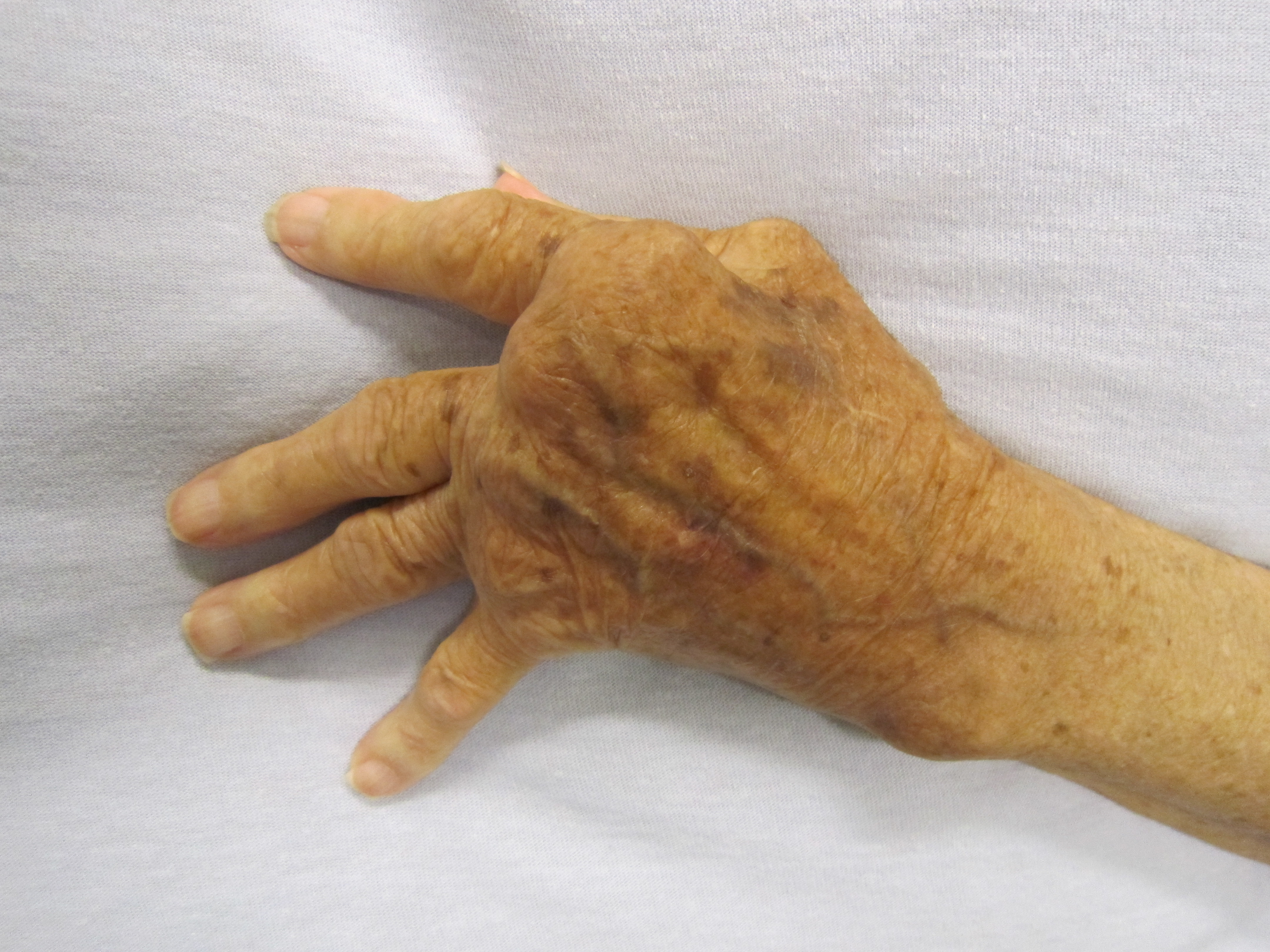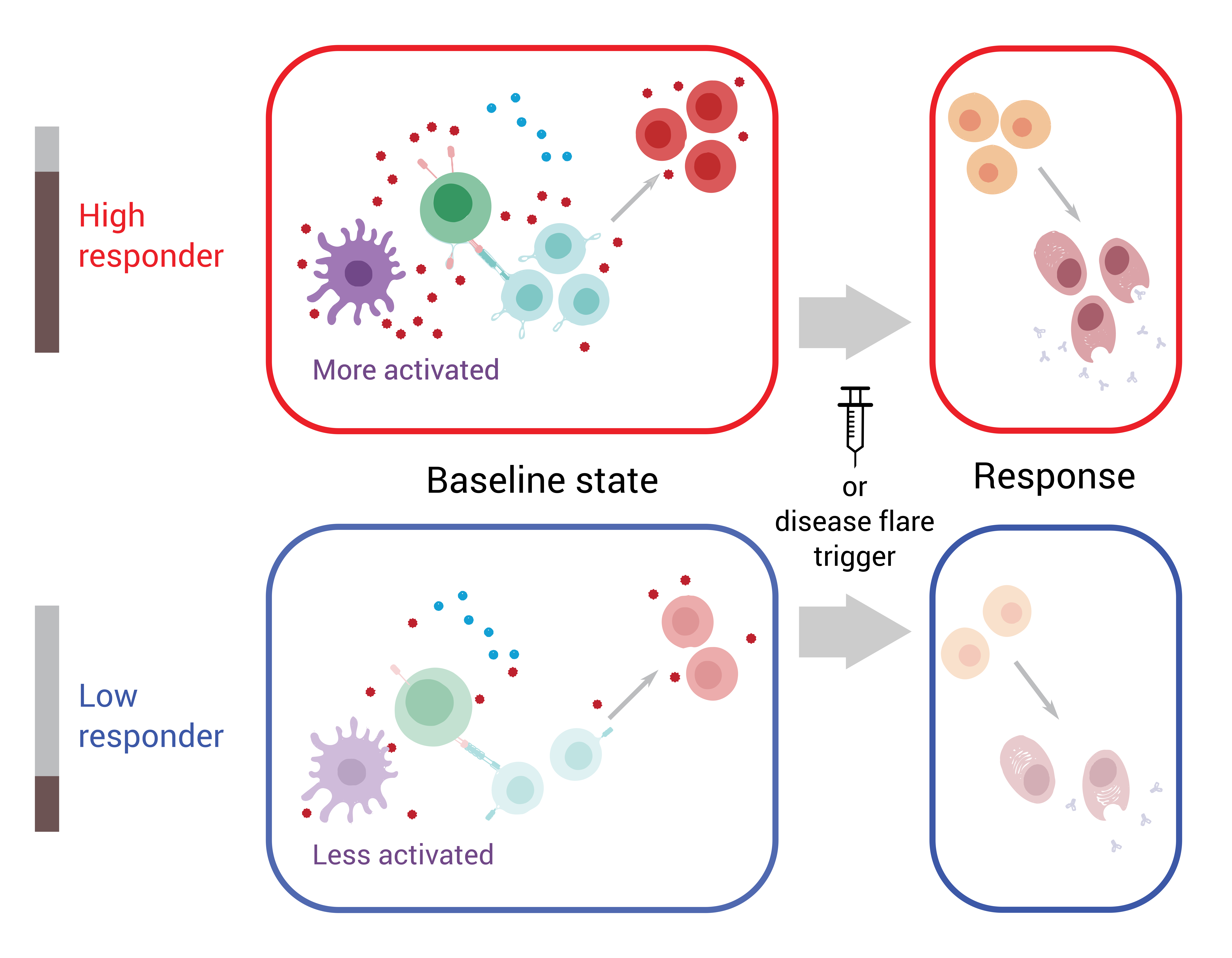NIAID supports a broad range of basic and clinical research on autoimmunity. Knowledge gained from basic research helps inform new experimental methods of diagnosis, prevention, and treatment, which are then evaluated in clinical studies.
Autoimmune Lymphoproliferative Syndrome (ALPS)
Autoimmune lymphoproliferative syndrome (ALPS) is a rare genetic disorder of the immune system that affects both children and adults. In ALPS, unusually high numbers of white blood cells called lymphocytes accumulate in the lymph nodes, liver, and spleen and can lead to enlargement of these organs. Read more about ALPS and ALPS research at NIAID.
Contact Program Officer: Jeffrey Rice ricejs@niaid.nih.gov / Stacy Ferguson fergusonst@niaid.nih.gov
Inflammatory Bowel Diseases (IBDs)
Inflammatory bowel diseases (IBDs), including Crohn’s disease and ulcerative colitis, cause inflammation of the digestive system. Crohn's can affect any area from the mouth to the anus and often affects the lower part of the small intestine called the ileum. Ulcerative colitis leads to sores on the large intestine, or colon. To learn about risk factors for these common IBDs and current prevention and treatment strategies visit the Crohn’s disease site from the National Institute of Diabetes and Digestive and Kidney Disorders (NIDDK) and ulcerative colitis site from NIDDK.
Contact Program Officer: Debbie Hodge hodged@mail.nih.gov
Multiple Sclerosis (MS)
Multiple sclerosis (MS) is a nervous system disease that affects the brain and spinal cord. MS damages the myelin sheath, the material that surrounds and protects nerve cells. This damage slows down or blocks messages between the brain and other body parts, leading to the symptoms of MS. To learn about risk factors for MS and current prevention and treatment strategies visit the multiple sclerosis information page from the National Institute of Neurological Disorders and Stroke.
Contact Program Officer: Mireia Guerau mireia.guerau@nih.gov
Psoriasis
Psoriasis is a skin disease that causes itchy or sore patches of thick, red skin with silvery scales. The patches usually appear on the elbows, knees, scalp, back, face, palms and feet, but they can show up on other parts of the body. Some people who have psoriasis also get a form of arthritis called psoriatic arthritis. To learn about risk factors for psoriasis and current prevention and treatment strategies visit the psoriasis site from the National Institute of Arthritis and Musculoskeletal and Skin Diseases.
Contact Program Officer: Stacy Ferguson fergusonst@niaid.nih.gov
Rheumatoid Arthritis (RA)
Rheumatoid arthritis (RA) is a form of autoimmune inflammation that causes pain, swelling, stiffness and loss of function in your joints. RA can affect any joint but is common in the wrists and fingers. To learn about risk factors for rheumatoid arthritis and current prevention and treatment strategies visit the rheumatoid arthritis site from the National Institute of Arthritis and Musculoskeletal and Skin Diseases.
Contact Program Officer: Stacy Ferguson fergusonst@niaid.nih.gov
Systemic Lupus Erythematosus
In lupus, the immune system attacks healthy cells and tissues by mistake. This can damage the joints, skin, blood vessels and organs. There are many kinds of lupus. The most common type, systemic lupus erythematosus, affects many parts of the body. Discoid lupus causes a rash that doesn't go away. Subacute cutaneous lupus causes sores after being out in the sun. Another type can be caused by medication. Neonatal lupus, which is rare, affects newborns. To learn about risk factors for lupus and current prevention and treatment strategies visit the systemic lupus erythematosus site from the National Institute of Arthritis and Musculoskeletal and Skin Diseases.
Contact Program Officer: Jeffrey Rice ricejs@niaid.nih.gov
Scleroderma
Scleroderma means “hard skin” and refers to a group of diseases that cause abnormal growth of connective tissue. Connective tissue is the material inside the body that gives tissues their shape and helps keep them strong. In scleroderma, the tissue gets too hard or thick and can cause swelling or pain in the muscles and joints. To learn about risk factors for sclerodorma and current prevention and treatment strategies visit the scleroderma site from the National Institute of Arthritis and Musculoskeletal and Skin Diseases.
Contact Program Officer: Jeffrey Rice ricejs@niaid.nih.gov
Type 1 Diabetes
Diabetes means a person’s blood glucose, or blood sugar, levels are too high. In type 1 diabetes, the pancreas does not make insulin. Insulin is a hormone that helps glucose get into cells to provide energy. Without insulin, too much glucose stays in the blood. Over time, high blood glucose can lead to serious problems with the heart, eyes, kidneys, nerves, and gums and teeth. Type 1 diabetes happens most often in children and young adults but can appear at any age. To learn about risk factors for type 1 diabetes and current prevention and treatment strategies visit the type 1 diabetes site from the National Institute of Diabetes and Digestive and Kidney Diseases.
Also read about the First FDA-Approved Drug for Delaying T1D Onset.
Contact Program Officer: Maggie Morris Fears maggie.morrisfears@nih.gov
Scientific Advances
First FDA-Approved Drug for Delaying Type 1 Diabetes Onset
April 17, 2023NIH-funded research helped pave the way for development of Teplizumab, the first FDA-approved therapeutic for delaying type 1 diabetes (T1D) onset in at-risk patients. This delay reduces the potential for severe long-term complications in patients, thereby improving their quality of life.
Antibodies Targeting Gut Bacteria Associated with Development of Rheumatoid Arthritis
October 19, 2022Rheumatoid arthritis (RA) is an autoimmune disease characterized by inflammation and joint destruction. As with many autoimmune diseases, RA disproportionally affects females. The development of RA is believed to involve complex interactions that include both environmental and genetic factors, and understanding the contributions of these factors continues to evolve. Recent studies have pointed to…

Ready, Set, Go—Immune System Status Predicts Future Responses
February 24, 2020Identifying predictors of autoimmune disease flare-ups could aid treatment by allowing doctors to intervene before symptoms worsen. Recognizing immune system attributes that forecast a healthy person’s response to vaccination or infection would help researchers develop new vaccines.



